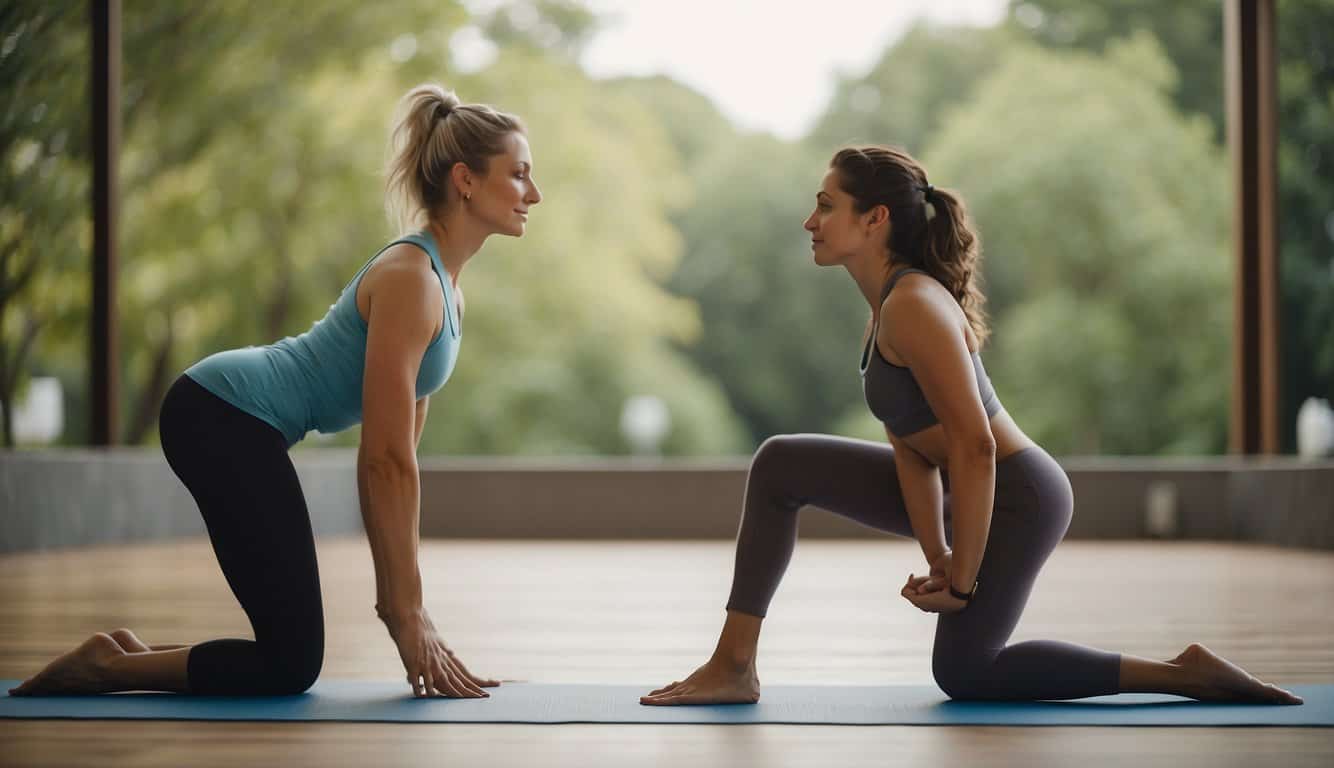Discovering the path of yoga leads to a diverse landscape of practices, each with its unique flavor and benefits.
Hatha yoga represents a gentle approach. It focuses on individual poses and embraces a slower pace that allows for deeper stretches and a stronger mind-body connection. It serves as a welcoming gateway for beginners to start understanding yoga’s physical and mental discipline.
Ashtanga yoga, in contrast, offers a more intense and fast-paced experience. It strings poses into a sequence executed synchronously with the breath, crafting a demanding routine that builds strength, endurance, and focus.

As one embarks on their yoga journey, understanding these differences is crucial to aligning personal goals with the right style.
Hatha yoga’s meditative and relaxed sessions cater to those seeking to improve flexibility and relieve stress, while Ashtanga’s rigorous flow challenges practitioners to push their limits and enhance cardiovascular fitness.
Both styles encourage progress through regular practice, leading you to improved health and self-awareness. Finding the practice that resonates with your needs and personality is key to cultivating a fulfilling yoga experience.
Key Takeaways
- Explore the unique aspects of hatha and ashtanga yoga to find the best fit for your journey.
- Recognize the slower pace of hatha yoga for flexibility and stress relief.
- Understand ashtanga yoga’s dynamic flow for building strength and cardiovascular health.
Origins and Philosophy

In exploring the roots of Hatha and Ashtanga yoga, you’ll uncover how these practices reflect their philosophical underpinnings and connect to Hinduism’s rich history.
Hatha Yoga Origins
Hatha yoga, a form of yoga originating from a Hindu context, dates back to the 15th century with the work of the yogic sage Swatmarama. Its detailed description can be found in the classic Sanskrit manual “Hatha Yoga Pradipika.”
The discipline emphasizes physical techniques and is often considered a preparatory stage for higher meditation.
The word “hatha” can be broken down into “ha,” meaning “sun,” and “tha,” meaning “moon,” signifying the union and balance of the body’s energies.
Ashtanga Yoga Roots
Ashtanga yoga, also deeply embedded in Hinduism, draws its heritage from an ancient text known as the “Yoga Korunta.”
The foundational aspects were later systematized by Patanjali, a sage who contextualized the philosophy into the “Yoga Sutras” around the second century.
This practice gained contemporary relevance through Sri K. Pattabhi Jois, a student of Sri T. Krishnamacharya. Jois helped popularize Ashtanga yoga, which is structured around Patanjali’s eight limbs and guiding principles that incorporate moral codes, postures, breath control, and meditation.
Core Principles and Practices
This section will explore the foundational elements and techniques that define Hatha Yoga and Ashtanga Yoga, offering you insights into their unique approaches to integrating body, mind, and spirit.

Hatha Yoga Fundamentals
Hatha Yoga is often considered the foundation of all yoga practices. It focuses on the balance between strength and flexibility. Central to Hatha Yoga are asanas (postures) and pranayama (breath control), which prepare you for deeper spiritual practices such as meditation.
Hatha Yoga gently initiates you into yamas and niyamas, which are ethical guidelines consisting of social and personal observances. The practice aims to align and calm your body, mind, and spirit in preparation for meditation.
With a slower pace, Hatha Yoga lets you hold poses longer, providing a deep stretch and an opportunity to align and refine your posture. The practice is accessible to beginners and emphasizes an introduction to the basic principles of yoga.
Ashtanga Yoga Principles
In contrast, Ashtanga Yoga is a more vigorous and structured approach. It is characterized by the synchronization of breath with a progressive series of postures, a process that produces intense internal heat and a purifying sweat.
The Ashtanga system typically follows six series of asanas, with each set having a specific focus and sequence.
Ashtanga strongly emphasizes vinyasa, the flow between asanas, and focuses on energy locks (bandhas) and gaze points (dristi).
Aside from physical elements, Ashtanga Yoga also intertwines aspects of the eight limbs of yoga, including yama, niyama, asana, pranayama, pratyahara (sense withdrawal), dharana (concentration), and dhyana (meditation), ultimately leading to samadhi (enlightenment or bliss).
This style is more demanding and suitable for those seeking to engage in a more active and rigorous yoga practice while incorporating spiritual elements.
Physical and Mental Benefits

In exploring the realms of Hatha and Ashtanga yoga, you’ll discover various physical and mental benefits tailored to enhance your overall well-being.
Each style of yoga offers unique attributes that can boost your health, strength, and flexibility while nurturing your meditation and relaxation practices.
Health Benefits of Hatha Yoga
Hatha yoga is often recommended for beginners due to its slower pace and focus on breathing techniques and meditation. This form of yoga emphasizes physical postures called asanas, which are held for longer periods. Through these postures, you can:
- Enhance flexibility by gently stretching and conditioning your muscles.
- Improve balance and core strength, reducing the risk of injury in daily activities.
Hatha also encourages deep relaxation, which can lead to a reduction in stress and an increase in mental clarity.
Advantages of Ashtanga Yoga
Ashtanga yoga might resonate with you if you’re seeking a more dynamic and structured yoga practice. Known for its powerful sequence of movements, Ashtanga provides:
- Cardiovascular health benefits through its continuous flow, aiding in weight loss and building physical strength.
- Synchronizing breath with movements is a path to mental focus, leading to a meditative state that helps develop discipline.
Ashtanga yoga can be particularly invigorating, often resulting in increased energy and positive well-being after each session.
Practice and Progression

Embarking on the yoga journey, you’ll find that the practice and progression in Hatha and Ashtanga Yoga are distinct paths tailored to different needs and goals.
Your progression will hinge on consistent practice, guidance from a seasoned yoga teacher, and a deeper understanding of your body’s capabilities and limitations.
Starting Hatha Yoga
When you begin your Hatha Yoga practice, you’re starting at a gentle pace. As a beginner, it’s important to focus on the basics of the poses (asanas) and breath control (pranayama), which serve as the foundation.
Your yoga teacher will guide you in performing each pose with proper alignment and may suggest modifications to cater to your individual needs. This enhances your physical strength, ensures safety, and helps prevent injury.
Take advantage of this slow pace to familiarize yourself with your body’s responses and gradually build your practice.
Advancing in Ashtanga Yoga
Progressing in Ashtanga Yoga is to embrace a more physically demanding practice that follows a specific sequence of poses.
This practice is characterized by its vigorous pace and the flow (vinyasa) that connects each movement. The series becomes increasingly challenging as you move from beginner to advanced levels.
Your Ashtanga journey is marked by mastering the primary series before moving on to the next. Physical strength and stamina are crucial, but the ultimate goal is to achieve mental clarity and focus.
As your guide, your Ashtanga yoga teacher will ensure you’re ready for the next level, often through mastering a specific set of poses and demonstrating consistency in your practice.
